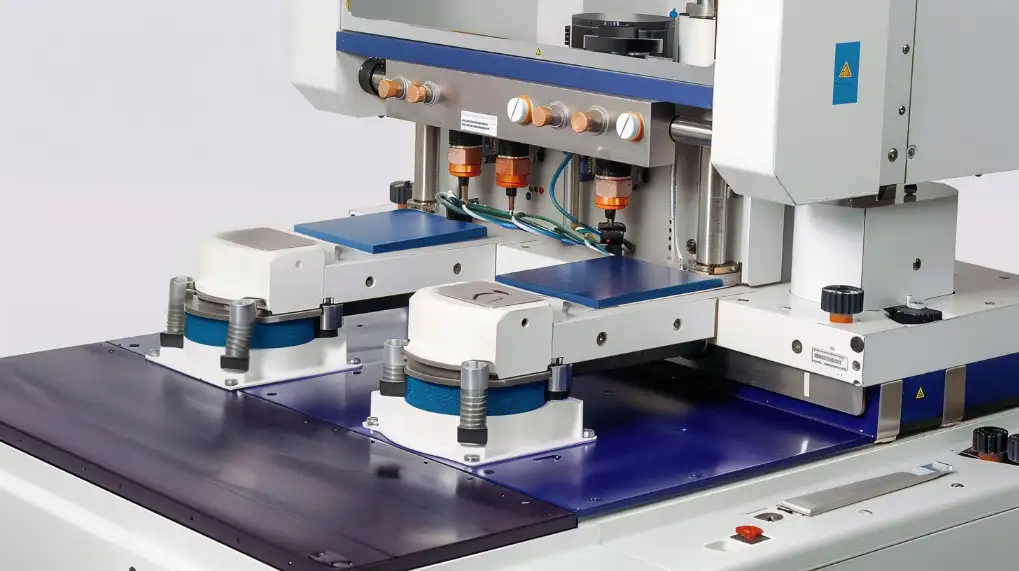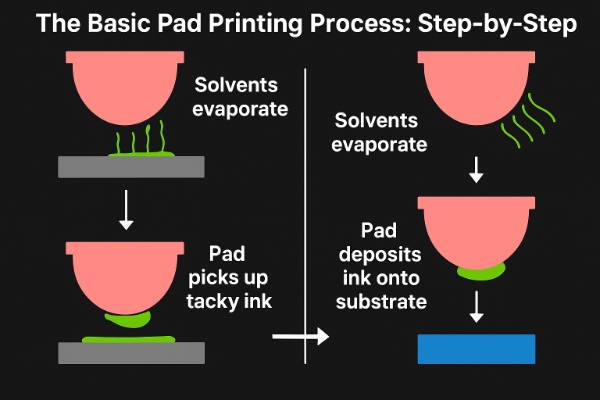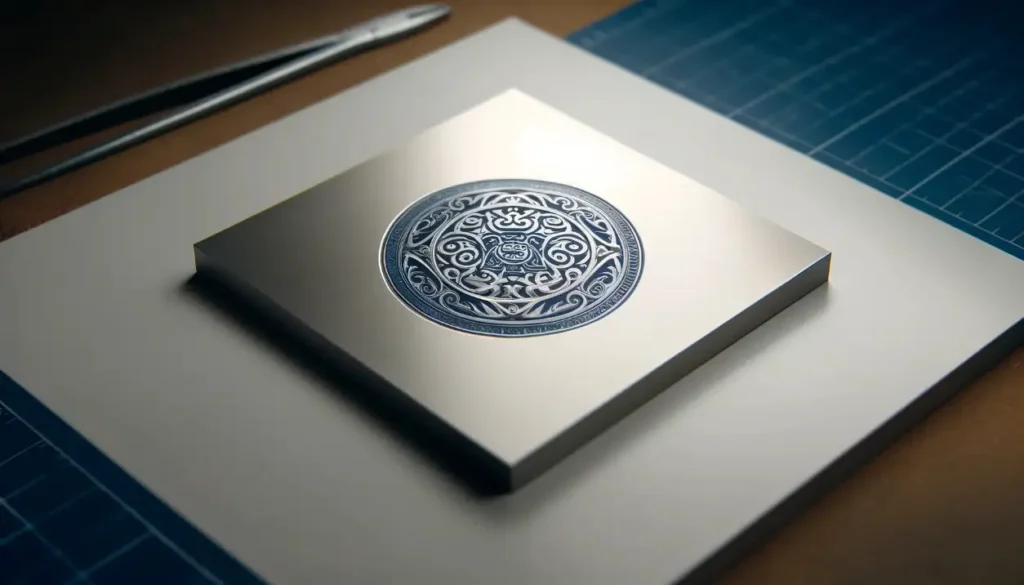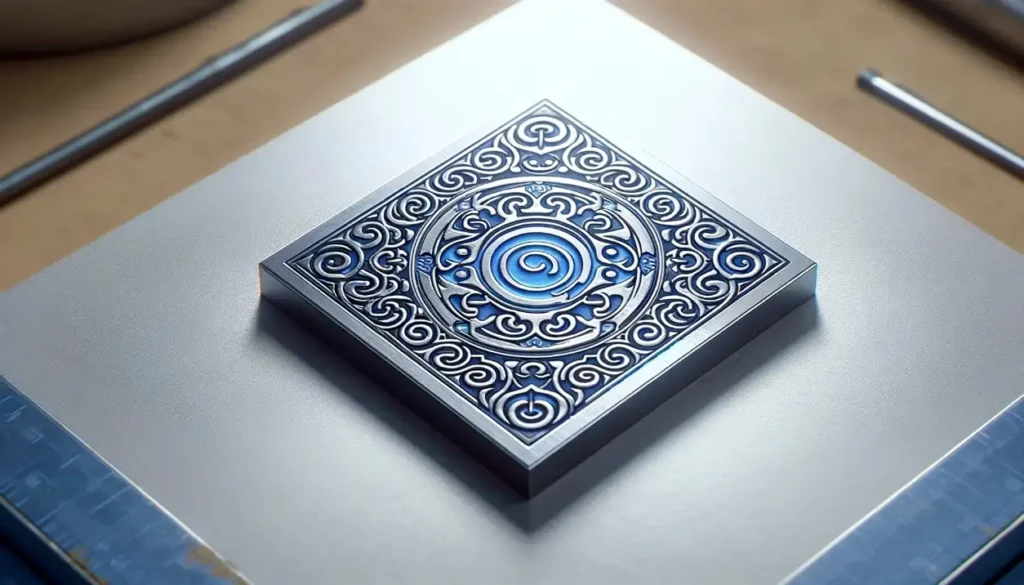Are you trying to print transparent logos or graphics on curved or uneven surfaces? Many items, like machine buttons and electronic parts, need small but clean markings. Traditional printing methods often can’t handle complex shapes well. Pad printing helps solve this issue. It works well on tricky surfaces and offers flexibility, speed, and fine detail.
Pad printing can create long-lasting marks on metal, plastic, glass, or ceramics. This method works for both high-volume runs and custom jobs. If you want to see why so many industries depend on this process, keep reading.
What is Pad Printing?
Pad printing is a printing method used to apply 2D images onto 3D objects. It works through an indirect process. A soft silicone pad picks up ink from an engraved plate and presses it onto the surface of a product. The plate, also known as a cliché, holds the image. The pad transfers the image by wrapping around the shape of the object.
This method is also known as tampography or tampo printing. It is ideal for printing on items with complex shapes. These include curved, concave, convex, cylindrical, or textured surfaces. Pad printing makes it possible to mark parts that would be difficult or impossible to mark using screen or digital printing.
It is widely used for logos, graphics, and symbols on small or hard-to-reach areas. Industries like electronics, medical devices, automotive, and promotional items rely on this technique.
Key Components of a Pad Printing Machine
Each part of a pad printing machine has its job. These parts work together in a set cycle to make sure the print comes out clean and clear every time. Here’s a breakdown of the main components.
Printing Plate (Cliché)
The printing plate holds the image you want to print. The design is etched or engraved into the surface. This etched part holds the ink. The rest of the plate stays dry. Plates can be made from steel or polymer, depending on how many prints are needed.
Ink Cup
The ink cup stores the ink and spreads it across the printing plate. It moves over the plate, presses down, and fills the etched design with ink. At the same time, it scrapes away extra ink from the surface. This keeps ink only in the areas that need it. The cup also covers the plate to keep the ink from drying out too fast.
Silicone Transfer Pad
The transfer pad picks up the ink from the plate and presses it onto the product. It’s made of soft silicone, so it can bend around curves or reach into uneven areas. Pads come in different shapes and hardness levels, depending on the shape of the part being printed.
Machine Base and Fixtures
The base of the machine holds the product still while printing. Custom fixtures are often added to keep parts in the right spot. This helps avoid misprints and keeps results the same from part to part.
Система контроля
The control system handles the timing and movement of the machine. It tells the ink cup when to move, the pad when to go up and down, and how long each step should take. Some machines work by hand, but most are powered by air pressure or electric motors for automatic operation.

How Does Pad Printing Work?
Pad printing follows a simple step-by-step cycle. The goal is to move ink from the etched plate to the part without losing image quality. Here’s how it works.
Step 1: Ink Filling in Home Position
The sealed ink cup rests over the etched artwork on the printing plate (cliché). It covers the image area completely and fills the engraved design with ink. This position is called the home position.
Step 2: Ink Exposure
The ink cup slides away from the etched design, removing excess ink and exposing the engraved image area. The ink left in the etched artwork begins to become slightly tacky when exposed to air, making it easier to transfer.
Step 3: Image Pickup by Silicone Pad
The silicone transfer pad presses down onto the printing plate. As it compresses, it forces air out and lifts the tacky ink from the engraved image onto the pad’s surface.
Step 4: Ink Transfer to Pad
When the silicone pad lifts away, the sticky layer of ink transfers cleanly from the plate to the pad. A thin layer of ink remains in the etched artwork on the plate.
Step 5: Plate Re-Inking
The ink cup simultaneously moves back to its home position over the etched artwork, refilling the engraved image area with ink. This prepares the plate for the next print cycle.
Step 6: Printing onto Product Surface
The silicone pad moves forward and presses onto the product’s surface—the ink transfers from the pad onto the object. After the ink is applied, the pad lifts away and returns to its home position, completing the printing cycle.

What are the Differences Between Screen Printing and Pad Printing?
Оба снимок экрана and pad printing are used to decorate parts. But they work in different ways and suit various shapes and production needs. Here’s how they compare.
Suitable Surfaces
Screen printing works best on flat and slightly curved surfaces. It uses a mesh screen to press ink through a stencil onto the part. If the surface is very uneven or complex, screen printing may not work well.
Pad printing is more flexible. It can print on flat, round, concave, or textured surfaces. The soft silicone pad adapts to different shapes, making it ideal for 3D parts like buttons, golf balls, or medical devices.
Image Resolution & Detail
Pad printing offers higher detail and sharper image quality. It’s excellent for fine lines, small logos, and tiny text. That’s why it’s often used for electronics, tools, or small parts.
Screen printing works well for bold designs and solid colors. But it may not handle wonderful details as cleanly as pad printing.
Ink & Color Handling
Screen printing allows thicker ink layers and bold, vivid colors. It’s excellent for outdoor items where bright and durable prints are needed.
Pad printing uses thinner ink films. It’s ideal for high-precision work where color control and clarity matter. It may require special ink types for better adhesion on some materials.
Скорость производства
Screen printing can be faster for large runs, especially with automated setups. Once set up, it prints quickly on batches of similar items.
Pad printing is better for shorter runs or mixed-product jobs. The setup is faster and more flexible, making it ideal for changing designs or part shapes.
Соображения стоимости
Screen printing may have higher setup costs due to screen creation. But it becomes more cost-effective for high-volume runs.
Pad printing has lower setup costs and works well for small to medium batches. It offers better value when dealing with many different product types or logos.
Плюсы и минусы тампопечати
Pad printing is widely used due to its flexibility and accuracy. But like any manufacturing method, it has strengths and drawbacks. Here’s a clear look at the advantages and disadvantages.
Плюсы:
- Высокая детализация и точность: Идеально подходит для создания сложных рисунков на небольших предметах.
- Универсальность на поверхностях: Эффективен даже на изогнутых, неровных и текстурированных поверхностях.
- Совместимость материалов: Работает с различными материалами, включая пластики и металлы.
- Точность цвета: Обеспечивает точную регистрацию цветов в многоцветных отпечатках.
- Кастомизация: Может быстро адаптироваться к индивидуальным формам и дизайнам.
Минусы:
- Стоимость первоначальной установки: Более высокие первоначальные затраты из-за изготовления пластин и колодок на заказ.
- Толщина чернил: Ограниченная толщина слоя чернил может повлиять на непрозрачность цвета.
- Обслуживание: Требуется регулярное обслуживание подушечек и печатных форм.
- Скорость производства: Этот метод может быть медленнее для больших пакетов, чем другие методы.

Common Applications Across Industries
Pad printing is used in many industries because it works well on different materials and shapes. It prints fine details on parts that other methods struggle with. Here are some key applications.
Электроника
Pad printing is used to mark buttons, switches, remote controls, and keyboards. These items often have small or curved surfaces. Pad printing applies symbols, text, and icons with sharp clarity and strong adhesion.
Медицинское оборудование
Medical parts need clean, accurate markings. Pad printing applies logos, dosage marks, or labels to syringes, catheters, inhalers, and other plastic or metal tools. The process is clean and works well with sterilization-friendly inks.
Автомобильные компоненты
Automotive parts like dashboard controls, knobs, or indicator lights often use pad printing. It can handle plastic, rubber, and coated metal surfaces. The printed marks stay sharp even with frequent use.
Promotional Items
Pens, keychains, phone stands, and mugs are often printed using this method. Pad printing is cost-effective and adjusts easily to different product shapes and materials.
Промышленность
Industrial equipment often requires permanent labels or safety symbols on parts. Pad printing adds these details to metal корпуса, панели, or tools. It performs well even on uneven or rough surfaces.

Factors to Consider During Pad Printing
Pad printing quality depends on careful control of several key elements. Each part of the setup affects how well the image transfers to the product. Here’s what to pay attention to.
Ink Type and Viscosity
The ink must match the material of the product. Some surfaces need fast-drying ink. Others need strong adhesion or resistance to wear.
Viscosity, or ink thickness, also matters. If the ink is too thick, it won’t transfer well. If it’s too thin, it may blur or spread. Solvent levels must be adjusted to keep the ink tacky at the right moment.
Cliché (Plate) Quality
The etched image on the plate must be sharp and clean. Poor etching leads to incomplete or blurry prints.
Steel clichés last longer and are used for high-volume runs. Polymer plates are more affordable and suitable for short batches. The depth of the etch affects how much ink the plate holds, which impacts print quality.
Pad Shape and Hardness
The pad must fit the shape of the part. A round pad may work for curved surfaces, while a flat one suits flat parts.
Pad hardness controls how much pressure it applies. A soft pad can bend around shapes. A harder pad gives sharper prints but may miss spots on uneven surfaces.
Printing Pressure and Speed
Too much pressure can distort the image or damage the part. Too little pressure leaves ink behind. Speed also matters. If the cycle is too slow, the ink may dry before transferring. If it’s too fast, the ink might smear.
Operators often adjust speed and pressure based on the ink type, part shape, and pad material. Proper balance ensures a clean and repeatable result.
Заключение
Pad printing is a straightforward and flexible way to add images or text to a product. It uses a soft silicone pad to move ink from an etched plate onto a surface. This method works well on flat, curved, or uneven shapes. It can print fine details like small logos, numbers, or symbols with reasonable accuracy.
Want sharp, dependable prints on your parts? Свяжитесь с нашей командой to see how pad printing can support your products.
Привет, я Кевин Ли

Последние 10 лет я занимался различными формами изготовления листового металла и делился здесь интересными идеями из своего опыта работы в различных мастерских.
Связаться

Кевин Ли
У меня более десяти лет профессионального опыта в производстве листового металла, специализирующегося на лазерной резке, гибке, сварке и методах обработки поверхности. Как технический директор Shengen, я стремлюсь решать сложные производственные задачи и внедрять инновации и качество в каждом проекте.
